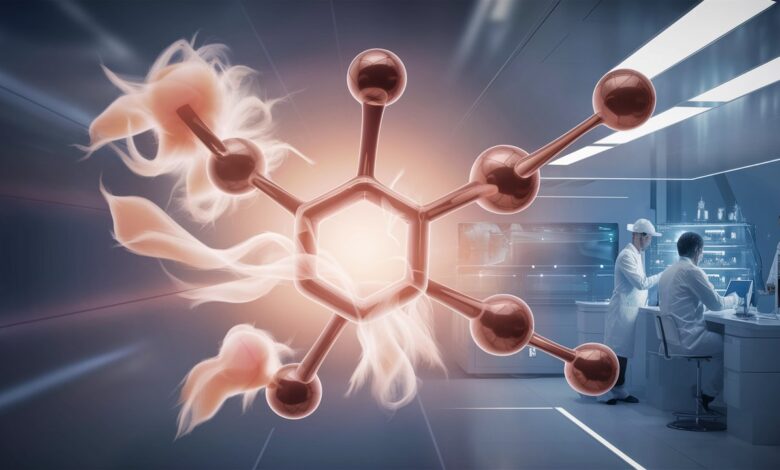
Introduction
Ammonia (NH₃), a seemingly simple compound of nitrogen and hydrogen, is a cornerstone of modern civilization, silently underpinning global food security, industrial processes, and emerging clean energy solutions. Its sharp, pungent odor is familiar to many, yet its profound impact on humanity remains underappreciated. Synthesized on an industrial scale exceeding 200 million metric tons annually, ammonia’s journey from laboratory curiosity to indispensable commodity is a testament to chemical ingenuity. This article delves deep into the multifaceted world of ammonia, exploring its fundamental properties, pivotal role in agriculture and industry, environmental challenges, and its promising future in a decarbonized world. Understanding ammonia is not merely an academic exercise; it is crucial for addressing pressing global issues like sustainable agriculture, climate change mitigation, and renewable energy storage.
What is Ammonia? The Chemical Foundation
Ammonia is a colorless alkaline gas composed of one nitrogen atom covalently bonded to three hydrogen atoms (NH₃), adopting a trigonal pyramidal molecular geometry with a lone pair of electrons on nitrogen. This unique structure grants ammonia exceptional polarity, making it highly soluble in water where it forms ammonium hydroxide (NH₄OH), a weak base. Its boiling point (-33°C) is unusually high for a molecule of its size due to extensive hydrogen bonding between molecules. Ammonia’s reactivity stems from its ability to act as a Lewis base, readily donating its lone electron pair to form coordination complexes with metals, acids, and electrophiles. Naturally occurring through anaerobic decomposition of organic matter, ammonia’s industrial significance lies in its synthetic production via the Haber-Bosch process, which revolutionized fertilizer production and earned two Nobel Prizes. This compound’s versatility arises from its dual nature: as a reactive building block for nitrogen-containing chemicals and as an efficient carrier of hydrogen atoms.
Industrial Production: The Haber-Bosch Process Revolution
The global supply of ammonia hinges almost entirely on the Haber-Bosch process, a catalytic reaction between nitrogen gas (N₂) extracted from air and hydrogen gas (H₂) typically sourced from natural gas. Conducted under high pressures (150–300 atmospheres) and elevated temperatures (400–500°C) over an iron-based catalyst, this process overcomes nitrogen’s extreme inertness by dissociating N₂ molecules on the catalyst surface, allowing recombination with hydrogen atoms. Developed in the early 20th century by Fritz Haber and Carl Bosch, this technology transformed agriculture by enabling mass production of nitrogen fertilizers, directly supporting over half the world’s population today. However, the process is notoriously energy-intensive, consuming approximately 1-2% of global energy output and contributing significantly to CO₂ emissions due to its reliance on fossil fuels for hydrogen production via steam methane reforming. Ongoing research focuses on integrating carbon capture, utilizing renewable electricity for hydrogen generation (electrolysis), and developing novel catalysts to lower temperature/pressure requirements, aiming to decarbonize this vital industrial backbone.
Agricultural Applications: Feeding the World Through Nitrogen Fertilizers
Ammonia’s paramount importance manifests in agriculture, where approximately 80% of global production is converted into nitrogen fertilizers like urea, ammonium nitrate, and ammonium phosphate. These compounds provide the bioavailable nitrogen essential for plant protein synthesis, chlorophyll production, and overall growth. Without synthetic ammonia fertilizers, Earth’s carrying capacity for humans would plummet by nearly half, highlighting their irreplaceable role in sustaining the global population. When applied to soil, fertilizers undergo nitrification—microbial conversion to nitrate (NO₃⁻)—which plants readily absorb. Yet, inefficiencies abound: only 30-50% of applied nitrogen is typically utilized by crops, with the remainder lost to leaching (causing groundwater pollution), volatilization (as ammonia gas or nitrous oxide, a potent greenhouse gas), and denitrification. Precision farming techniques, controlled-release fertilizers, and enhanced-efficiency formulations are critical innovations aimed at boosting nitrogen use efficiency, minimizing environmental damage while maintaining crop yields in an era of climate stress and resource scarcity.
Industrial and Commercial Uses Beyond Fertilizers
Beyond agriculture, ammonia’s reactivity and physical properties enable diverse industrial applications. As a refrigerant (R-717), it boasts superior thermodynamic efficiency, zero ozone depletion potential (ODP), and negligible global warming potential (GWP) compared to synthetic hydrofluorocarbons. Its high latent heat of vaporization makes it ideal for large-scale cooling in food processing, cold storage warehouses, and industrial chillers, though its toxicity necessitates robust system design and safety protocols. Ammonia serves as a crucial chemical precursor, forming the basis for manufacturing explosives (via nitric acid synthesis), plastics (e.g., nylon through adiponitrile), synthetic fibers, dyes, pharmaceuticals, and household cleaning agents where its alkalinity effectively dissolves grease and stains. In water treatment, chloramine (formed from ammonia and chlorine) provides longer-lasting disinfection than chlorine alone. Emerging applications include flue gas desulfurization to reduce sulfur emissions from power plants and as a reducing agent in selective catalytic reduction (SCR) systems, breaking down nitrogen oxides (NOx) from diesel engines into harmless nitrogen and water vapor.
Environmental Impact and Safety Considerations
Ammonia presents a dual environmental narrative: it sustains humanity while posing significant ecological and safety risks. Volatilized ammonia from fertilized fields and livestock waste contributes to atmospheric pollution, forming secondary particulate matter (PM2.5) that impacts air quality and human health. Runoff into waterways causes eutrophication—explosive algal blooms that deplete oxygen, killing aquatic life and creating “dead zones.” Furthermore, microbial processes in soil convert excess fertilizer into nitrous oxide (N₂O), a greenhouse gas 300 times more potent than CO₂ over a century. Safety hazards are equally critical; ammonia gas is toxic, causing severe respiratory distress at concentrations as low as 300 ppm, and is flammable at 15–28% volume in air. Industrial accidents—often due to pipeline ruptures or refrigeration leaks—underscore the need for rigorous handling protocols, leak detection systems, and emergency preparedness. Mitigating these impacts requires integrated strategies: optimizing fertilizer application, adopting anaerobic digesters for manure management, enhancing industrial containment technologies, and advancing wastewater treatment to recover nitrogen.
The Future is Green: Ammonia as a Clean Energy Vector
“Green ammonia” represents a paradigm shift, positioning NH₃ as a linchpin in the renewable energy transition. Produced using hydrogen from water electrolysis (powered by wind/solar) and nitrogen from air via renewable-energy-driven Haber-Bosch or emerging electrochemical processes, green ammonia achieves near-zero carbon emissions. Its potential extends far beyond fertilizers: as an energy-dense (12.7 MJ/L), carbon-free fuel for maritime shipping and power generation, where it can be combusted directly (with NOx emission controls) or decomposed back into hydrogen for fuel cells. Crucially, ammonia’s liquefaction at moderate pressures (-33°C at 1 atm or 25°C at 10 atm) facilitates safer, denser storage and transport compared to liquid hydrogen (-253°C), making it a viable solution for global hydrogen distribution. Pilot projects—like ammonia-powered ships and ammonia-coal co-firing in power plants—are underway, while research focuses on efficient “cracking” catalysts to release hydrogen and low-NOx combustion technologies. Realizing this vision demands massive scaling of renewable energy, electrolyzer manufacturing, and retrofitting infrastructure, positioning green ammonia as a critical enabler of a sustainable energy economy.
Conclusion
Ammonia’s story is one of transformative power and profound responsibility. From catalyzing the Green Revolution to emerging as a potential clean energy hero, this unassuming molecule remains indispensable to human progress. Yet, its environmental toll—from greenhouse gas emissions to ecosystem disruption—demands urgent innovation in production and management. The pursuit of green ammonia epitomizes this balancing act, offering a pathway to decarbonize both agriculture and heavy industry while unlocking renewable energy storage at a global scale. As humanity confronts climate change and resource limitations, ammonia’s evolution from chemical workhorse to sustainability linchpin will be pivotal. Embracing this potential requires collaborative investment in technology, infrastructure, and circular economy principles to ensure ammonia truly becomes a foundation for a resilient, nourished, and low-carbon future.
Frequently Asked Questions (FAQs)
Q1: Why does ammonia have such a strong smell?
Ammonia’s penetrating odor—often described as pungent or “chemical-like”—is detectable by humans at concentrations as low as 5 parts per million (ppm). This high olfactory sensitivity serves as a natural warning system because ammonia is an irritant. The odor results from ammonia molecules binding to receptors in the nasal passages, triggering nerve signals to the brain. While low concentrations are common in household cleaners, persistent or strong odors may indicate hazardous leaks in industrial or refrigeration contexts, warranting immediate ventilation and inspection.
Q2: Can ammonia be used directly as a fertilizer?
Yes, anhydrous ammonia (pure NH₃ gas under pressure) is applied directly as a fertilizer, particularly in large-scale farming regions like the US Midwest. Injected 10-20 cm deep into soil using specialized equipment, it reacts with soil moisture to form ammonium ions (NH₄⁺), which bind to soil particles, minimizing volatilization. Direct application is cost-effective but requires careful handling due to its corrosiveness and toxicity. Farmers must manage risks like soil compaction, nitrogen loss if injection is shallow, and potential acute exposure during refilling operations.
Q3: How does ammonia contribute to climate change?
Ammonia’s climate impact is indirect but significant. First, its production via the Haber-Bosch process emits ~1.8 tons of CO₂ per ton of ammonia due to fossil fuel-based hydrogen generation. Second, when over-applied as fertilizer, soil microbes convert excess nitrogen into nitrous oxide (N₂O), which accounts for ~6% of global greenhouse gas emissions with 265 times the warming potential of CO₂ over 100 years. Mitigation strategies include adopting renewable energy for synthesis, optimizing fertilizer efficiency, and implementing nitrification inhibitors to reduce N₂O formation.
Q4: What safety measures are critical for ammonia handling?
Key safety protocols include:
- Ventilation & Detection: Install ammonia sensors with alarms in storage/usage areas; ensure continuous airflow.
- Personal Protective Equipment (PPE): Use chemical-resistant gloves, goggles, face shields, and respirators for concentrated solutions or gas.
- Containment: Employ pressure-relief valves, double-walled tanks for bulk storage, and secondary containment to catch leaks.
- Training: Educate personnel on emergency procedures (e.g., eye/skin flushing, leak containment) and first aid.
- Compliance: Adhere to regulations like OSHA’s Process Safety Management (PSM) for large-quantity facilities.
Q5: What makes “green ammonia” sustainable?
Green ammonia is produced using renewable energy throughout:
- Green Hydrogen: Water electrolysis powered by wind/solar generates H₂ without CO₂ emissions.
- Air Separation: Renewable electricity extracts N₂ from air.
- Synthesis: Haber-Bosch reactors or electrochemical cells powered by renewables combine N₂ and H₂.
This eliminates the 1.5–2 tons of CO₂ typically emitted per ton of conventional (“grey”) ammonia. Green ammonia enables carbon-free fertilizers, zero-emission shipping fuel, and long-term renewable energy storage, closing loops in the nitrogen and carbon cycles.



